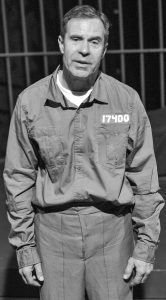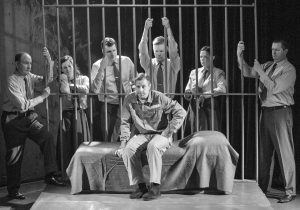THE LONE EAGLE VERSUS THE LONE WOLF
81 years ago, everything conspired to make the “trial of the century” engrossing entertainment. (Actually, it was the second trial of the century–after the Leopold and Loeb murder tribunal–but who’s counting?) There was the horror of the kidnapping and killing of the 20-month-old baby of American idols Charles and Anne Morrow Lindbergh, then the witchhunt and scapegoating of a bumbling outsider named Bruno Richard Hauptmann. (H.L. Mencken called it “the biggest story since the Resurrection.”) Still potent, this sheer sensationalism makes John Logan’s taut 1985 recreation courtroom-drama catnip.
Returning for the fifth time to the show that he directed 30 years ago in its premiere by the late Stormfield Theatre, Terry McCabe delivers one more piledriving revival: The 100-minute two-act drama fully recreates the media frenzy, the kangaroo court, and the hilariously boneheaded testimony, with sarcastic commentary from George Seegebrecht as the self-proclaimed innocent defendant.
There’s no question of Hauptmann’s rage at winning, not fortune but infamy, in America, the promised land to which he emigrated in 1923 (fleeing a somewhat criminal past): Shame and suffering are not how his beloved Astaire-Rogers fantasies ended. Lindbergh, the blonde native prince, has luck, looks and a legend. And now he wants this loser’s life. The clash between “Lucky Lindy” and the “baby killer” feels patently unfair, classic American asymmetry: Speaking from his prison cell, this unprepossessing Hauptmann seems to anticipate Herb Stempel, the mousy geek who was forced to lose to golden-boy Charles Van Doren in the 1950s’ quiz scandal. A fix is in.
 Hauptmann’s muted testimony exploding into the rage of the unjustly condemned, Seegebrecht gives the plaintive plaintiff a volatile mix of self-destructive irreverence and underdog resilience. The unlucky schmuck has reason to feel railroaded: He only had $4,000 to spend on his paltry defense versus $1 million for the state—and, unlike the “thrill killers” of 1924, he had no scrappy crusader like Clarence Darrow in his corner.
Hauptmann’s muted testimony exploding into the rage of the unjustly condemned, Seegebrecht gives the plaintive plaintiff a volatile mix of self-destructive irreverence and underdog resilience. The unlucky schmuck has reason to feel railroaded: He only had $4,000 to spend on his paltry defense versus $1 million for the state—and, unlike the “thrill killers” of 1924, he had no scrappy crusader like Clarence Darrow in his corner.
As Hauptmann’s persecutors (except for Sheila Willis as Bruno’s self-effacing hausfrau), the seven ensemble members are lions sniffing an injured antelope. Ryan David Heywood resembles the air-brushed Lindbergh who, if we can believe this play, will forgive the convicted criminal before his electrocution. Kat Evans is demurely defensive as Lindbergh’s literary wife, Brian Pastor bullying and brusque as the prosecutor, and Robert Kaercher suitably serviceable as Judge Trenchard. Replaying the role that he originated 30 years ago, Jerry Bloom is unctuously ambitious as Dr. John F. Condon, the catspaw go-between linking Lindbergh to the supposed kidnappers.
As always, Logan masterfully crafts suspense and irony: In the midst of a tempestuous, circus-like trial, we hear sadly similar stories from both wives about March 1, 1932, the last night that the women could fully enjoy their babies. As Never the Sinner (recently revived at Victory Gardens Theater) reveals, Logan abounds with sympathy for life’s underdogs. The playwright sows plenty of doubt about whether Hauptmann, an illegal immigrant (sound familiar?), was anything more than a patsy framed three years after the crime in order to placate a public that wanted “closure.”
At worst, Hauptmann depicts the title character as a bag man for the ransom money left with him by another German, Isidor Fisch, who went on to die during a vacation in Germany. Or was the home invasion an “inside job” perpetrated by a maid named Violet Sharp who had inside information that the Lindbergh family would stay an extra day at their weekend country home in Hopewell, New Jersey—and who would later, conveniently or otherwise, commit suicide? Did the carpenter act alone, his guilt revealed by the similarity of the handwriting and spelling on certain documents to his own or the fact that the wood used in the tell-tale ladder was traced to his New York home? After all, Hauptmann did have $14,000 of the $70,000 ransom money hidden in a shoebox.
Yes, the case against B.R.H. was entirely circumstantial—no witnesses, no confession, and, in the 1930s, no chance of a DNA match. But the problem with lumping Hauptmann along with The Exonerated—and other case histories in The Innocence Project–is that, for all his forensic arguments and emotional empathy with this perfect “victim,” Logan leaves Hauptmann’s complicity or innocence in deep doubt.
We’re left wondering, both about Hauptmann’s fantasy of how the crime really happened and at the convenience of his courtroom collapse under grilling from Brian Pastor’s bulldog prosecutor. The trial was a travesty, but that doesn’t make Hauptmann a suitable martyr to indict our xenophobic, paranoid and malleable court system. Ultimately Logan is too faithful to the facts to completely convince a 2016 “courtroom.” But as theater Hauptmann remains a slam dunk.
photos by Paul Grigonis
Hauptmann
City Lit
Edgewater Presbyterian Church
1020 West Bryn Mawr Ave.
Fri & Sat at 7:30; Sun at 3
Thurs (June 30 & July 7) at 7:30
ends on July 10, 2016
for tickets, call 773.293.3682 or visit City Lit
for more shows, visit Theatre in Chicago

